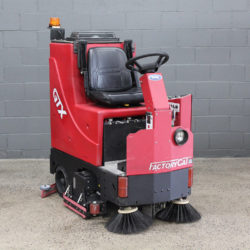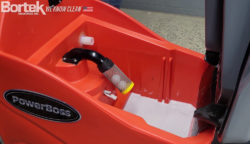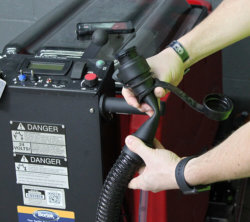How to Operate a Floor Scrubber
Choosing a Floor Scrubber
 When you are dealing with a floor space that is too large for a mop and a bucket, you might want to investigate more efficient options. A mop with a handle might be an improvement over the rag, and your hands and knees, but modern industrial spaces are much larger and harder to cover by manpower alone. That’s why a commercial floor scrubber is the right choice for your cleaning needs.
When you are dealing with a floor space that is too large for a mop and a bucket, you might want to investigate more efficient options. A mop with a handle might be an improvement over the rag, and your hands and knees, but modern industrial spaces are much larger and harder to cover by manpower alone. That’s why a commercial floor scrubber is the right choice for your cleaning needs.
The Factory Cat Micro-HD and other walk-behind scrubbers just like it can represent a cost-effective solution for surfaces of moderate size. These scrubbers can be self-propelled, so the operator merely needs to guide its path. They allow you to combine water with a cleaning solution to help you clean more effectively. And finally, scrubbers also come in a number of scrub path widths, making them a versatile option for a variety of tasks.
Ride-on scrubbers, such as the PowerBoss Admiral 48, offer increased efficiency for larger floor surfaces. These machines enable the operator to cover large areas while avoiding the wear-and-tear of walking for long periods of time. With increased capacity for cleaning solution and dirty recovered water, these scrubbers also allow the operator to cover more ground between stops for waste elimination.
To decide which style is right for you, consider the size of your cleaning areas, the labor cost involved in cleaning those areas, and your budget. Sweeperland has options to suit every need and budget, with an expert staff ready to help you make the best decision for your company. On this page, we will give you a quick rundown of how to operate a floor scrubber.
Getting Started With Your Floor Scrubber
 If you were to clean a large warehouse floor the old fashioned way, by the time you finished, the floor would be ready for the next round of cleaning. For most jobs, a walk-behind cleaner will do the trick, but for the largest floor spaces, a ride-on model will give you maximum efficiency.
If you were to clean a large warehouse floor the old fashioned way, by the time you finished, the floor would be ready for the next round of cleaning. For most jobs, a walk-behind cleaner will do the trick, but for the largest floor spaces, a ride-on model will give you maximum efficiency.
- Before starting, remove loose debris and dirt from the floor. This will save time on the job, and wear and tear on the scrubber’s pad/brush and vacuum system. This also reduces the risk of merely spreading the dirt around the floor or worse – grinding it into the floor surface and causing permanent damage.
You can do this by pre-sweeping with a sweeper machine or, depending on your scrubber model, a sweeping option may be built into your machine. Scrubbers with cylindrical brushes may be able to handle small-sized dirt and debris without pre-sweeping, but large debris should still be cleared in advance. - Fill the machine’s solution tank (aka “intake tank”) with water and detergent to the manufacturer’s specifications. Your floor scrubber may not be designed to run “dry”, so don’t forget this step.
Pro Tip: Use low-foaming detergent designed for floor scrubbers to mitigate suds rising up into the vac motor. Also, put the water in first, followed by the detergent. - If possible, for maximum efficiency, start cleaning in the corner furthest away from the door and work your way back to the door. If you can do this, you will avoid covering a portion of the floor a second time just to leave the room.
Also, this probably goes without saying, but scrubbers are generally designed to clean while moving forward, so don’t expect any results while going in reverse. - Double-check the scrubber pad or brush to make sure it is fastened securely.
- Turn on the machine according to the manufacturer’s instructions.
- If equipped, make sure the squeegee is in the down position and making even contact with the floor.
Properly positioning the squeegee is one of the most important steps to getting good results, and one of the most overlooked.
The squeegee should be horizontally level and have the right pitch to allow water through the slits in front without letting it escape out the back squeegee – the dirty water on the floor should end up between the two squeegees to be collected by the vacuum. - Activate any solution flow and vacuum systems if your scrubber doesn’t start them automatically.
Methodology of Cleaning with a Floor Scrubber

- Go slowly, working in straight, parallel rows back and forth across the floor. By overlapping each pass slightly, you can avoid missing spots.
- If your unit is equipped with these options, adjust the water flow level and brush pressure as necessary, using just enough of each to complete the job.
- Keep an eye on the recovery tank and empty it as necessary.
- Keep an eye on the solution tank as well, adding more water when necessary.
- If your scrubber does not dry as it goes (most do), allow time for the floor to dry and dispose of the floor pads in accordance with the directions.
- When you are finished, don’t forget to plug your unit into its charger. A floor scrubber with a dead battery is no use to anyone.
Managing Excess Foam
 To avoid foaming in your solution tank, add the water first, then the detergent second. This will keep agitation and foam buildup to a minimum. Riding scrubbers tend to create more foam than walk-behind scrubbers. An overabundance of foam in the recovery tank can overflow into the vacuum motor and cause expensive damage, so take this seriously! There should only be a small layer of dirty foam on the surface.
To avoid foaming in your solution tank, add the water first, then the detergent second. This will keep agitation and foam buildup to a minimum. Riding scrubbers tend to create more foam than walk-behind scrubbers. An overabundance of foam in the recovery tank can overflow into the vacuum motor and cause expensive damage, so take this seriously! There should only be a small layer of dirty foam on the surface.
Another beneficial step would be to add a de-foaming agent to the recovery tank, which experiences more agitation as a part of the cleaning process. In the case of an exceptionally dirty floor, it would be a good idea to use less on a first pass, so the detergent doesn’t mix with the dirty water to create more foam. Pre-washing the floor by making one pass with the suction system disengaged and the squeegee raised can help as well.
We very strongly recommend that you only use detergents that are designed for use in floor scrubbers. We have a selection of scrubber chemicals available to order online, many of which we make in-house with the benefit of years of experience figuring out the perfect mixtures.
After you have finished scrubbing the floor, rinse the recovery tank thoroughly to prevent chemical buildup that could lead to foam buildup in the future. This will also mitigate the possibility of an adverse reaction with different cleaning products that may be used in the future. Ammonia, diluted in water, can help remove difficult materials like floor wax that might build up.
In addition to the recovery tank, routine cleaning of other parts will help to reduce chemical and detergent buildup. Hoses, filters and squeegees are common places for buildup, and are simple to clean. Adding these parts to a frequent cleaning routine can help extend the life of your floor scrubber.
Draining the Recovery and Intake Tanks
Your floor scrubber’s intake tank may not have sufficient capacity to complete your cleaning without a refill. If you are keeping an eye on your recovery tank, you will clearly be able to see when it is time to dump the dirty water. Doing so will prevent the buildup of foam and detergent residue that can lead to excess foam. And, of course, at the end of the job, you will also need to empty and clean the tanks.

Awareness of the level in the recovery tank will also ensure that you can get to your designated dumping area in a timely manner. You should be able to turn off the water pump and vacuum systems when transporting the unit to the dumping area. There is no need to clean a path to your dump site if you are going to go over that area eventually, anyway.
When you dump the dirty water from the recovery tank, take into account the chemicals or detergents used in the cleaning process. Be mindful of the environment and co-workers when you discard the dirty water. If the chemicals involved are too dangerous to be sent to public drainage systems or ground water, refer to either the label’s disposal instructions or your company’s own chemical disposal protocols.
Most floor scrubbers have two tanks – one for the clean water and solution (the intake or solution tank), and one for the dirty water (the recovery tank). Be sure to read the instruction manual for your scrubber prior to operation and know which is which. Some units have removable tanks, so be sure to learn in advance how to remove and reattach them properly. You don’t want to be stranded in the middle of the floor with a tank full of dirty water, only to realize that you don’t know how to remove the tank.
When you are finished with a job, never leave dirty water in the recovery tank. This will promote buildup of foam and potentially harmful chemicals, and will reduce the effective life of your floor scrubber.
 Pro Tip: Kink the hose a little near the end where you hold it before letting out the dirty water. This will help you to keep the flow under control when it rushes out. Once the flow of dirty water is controlled, you can just let the hose sit by the drain to finish draining. Thoroughly spray out the recovery tank with the drainage hose still at the drain to clean out the residual dirt and detergent.
Pro Tip: Kink the hose a little near the end where you hold it before letting out the dirty water. This will help you to keep the flow under control when it rushes out. Once the flow of dirty water is controlled, you can just let the hose sit by the drain to finish draining. Thoroughly spray out the recovery tank with the drainage hose still at the drain to clean out the residual dirt and detergent.
If your scrubber has a cylindrical scrub deck, it likely has a small debris hopper which should be emptied and cleaned daily as well.
Storing Your Commercial Floor Scrubber
As with any other large piece of equipment, you’ll want to store your floor scrubber in a dry location. If for some reason you will be storing your floor scrubber for a longer period of time, remove the battery leads to prevent leakage of the battery acid. Keep in mind that wet batteries may require additional routine care and maintenance, though this can be made easier with a battery watering system.
Additional Advice
Choosing the Right Scrub Pad
Different surfaces call for different scrubbing materials. Harder scrub pads can damage painted and wooden surfaces, so use the right scrubbing head for your surface – a softer pad for painted surfaces, or harder for hard surfaces like concrete. Different jobs also require different scrub pads. Are you merely cleaning the floor or stripping the wax? Make sure you have the appropriate scrub pad for this particular task.
We have a guide for choosing a scrubber pad here, but you should still confirm with an expert to be safe.
Not sure what part you need? Let us help you find it!
Safety Measures
Before you use your floor scrubber, we recommend that you follow a few basic safety measures. While these aren’t inherently dangerous machines, the minimum safety gear listed below will ensure that you are protected from the most common potential issues.
 Hearing Protection
Hearing Protection
The NIDCD indicates that prolonged exposure to sounds above 85 decibels can lead to Noise-Induced Hearing Loss (NIHL). While it is true that most floor scrubbers operate at a noise level below that threshold thanks to their quieter electric motors, gas and diesel power motors can approach that 85 decibel level. Consider also that these figures refer specifically to the scrubbers themselves instead of the environment.
When operating in an enclosed space, the noise level can be amplified somewhat as the sound bounces off the walls and back to your ears. For your own safety, employ at least a minimum of ear protection. Foam plugs, when used properly, can provide adequate protection in most cases. In louder environments, full size, around-the-ear headphones will offer the best possible protection.
When it comes to listening to music with headphones while you work, remember that noise is additive. If you need to turn up the volume of your music to be able to hear it over another noise source, it means your music has to be louder than the other source, and then you’ve got two loud noises in your ears. Therefore, listening to music while operating noisy equipment can lead to NIHL and is not recommended.
Shop our hearing protection products
 Respiratory Protection
Respiratory Protection
The water and detergent used in the scrubbing process should limit the amount of airborne particulates, but it is still possible that some dust could be kicked up into the air. Be sure to don a simple dust mask just to avoid breathing in any of the dirt and dust you are cleaning. This is especially important if you are cleaning area that contains potentially harmful materials. If you are using your floor scrubber to strip the wax from a floor surface, the chemicals involved, while harmless in small exposures, might potentially be harmful over the course of a large cleaning job. When in doubt, follow the warning and precaution labels on the container of the cleaning agent.
 Eye Protection
Eye Protection
The scrubbing pads on even the smallest floor scrubbers can rotate at speeds of over 200 RPM. Ideally, you have removed excess debris and all potential projectiles have been cleared beforehand, but if the scrub pad does pick something up, it is best to have eye protection just in case.
Shop our eye protection products
 Comfortable shoes
Comfortable shoes
This may go without saying, but if you are operating a walk-behind scrubber, in order for that machine to clean every square inch of the floor, you will also have to cover every square inch on foot. In the case of the Factory Cat Micromag, for example, with its 17″-20″ scrub path, allow a few inches for overlapping passes. A good rule of thumb would be to convert square footage of your cleaning area into your overall distance traveled. The conversion isn’t precise, but it is close enough for our purposes. If you are cleaning a 10,000 sq. ft. warehouse floor, you will be walking almost two miles. Are you prepared to walk two miles in the shoes you wear to work?
While you are at it, check to see if your handles are adjustable. If so, find a comfortable height so you don’t risk undue injury or fatigue during a long session.
 Gloves
Gloves
You shouldn’t need gloves to operate the scrubber in normal use, but depending on the chemicals and detergents used in the cleaning process, you may want to use gloves when pouring additives into the intake tank. You may also want to wear protective gloves when performing maintenance on the mechanical parts of the floor scrubber. In the case of the chemicals, refer to the handling instructions on label on the container. In the case of maintenance work, use your best judgment. As always, consult the owner’s manual before beginning any maintenance task.
Bortek’s Selection
Bortek has the best selection for commercial and industrial floor scrubbers and warehouse cleaning equipment. We have a variety of models to cover just about every possible surface. Our friendly, knowledgeable staff will be happy to assist you in selecting the right model for your company, and also in selecting the accessories and tools to help you get the most out of your floor scrubber.
Take a look around our website and contact our staff with any questions you may have, or to place an order. We look forward to working with you.
